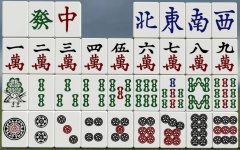Mahjong equipment: Difference between revisions
m (→Tenbou) |
|||
| Line 51: | Line 51: | ||
==Tenbou== | ==Tenbou== | ||
Point sticks are used to keep track of scores. In a sense, these sticks may be viewed as "money". Although, some gambling games may actually tie these point sticks to money. | |||
In the event of [[Scoring|honba]], players use 100 point sticks and add them to the round indicator. These merely serve as markers, and when a dealer rotation occur, players keep their 100 point sticks used to keep track of the honba count. | |||
{| class="wikitable" width="40%" align="right" | {| class="wikitable" width="40%" align="right" | ||
|- | |- | ||
| Line 61: | Line 64: | ||
| align="center"| [[Image:Tenbou 10K.png]] || 10000 point stick | | align="center"| [[Image:Tenbou 10K.png]] || 10000 point stick | ||
|} | |} | ||
At the start of the game, players begin with the regular 25,000 points: | At the start of the game, players begin with the regular 25,000 points: | ||
* A single 10,000 stick | * A single 10,000 stick | ||
Revision as of 08:39, 28 September 2013
Of course, the proper equipment is needed in order to play Japanese mahjong. Naturally, mahjong tiles are used. It is possible to play the game using printed cards; yet, it is actually cumbersome to do so. In practice, tiles have been the most effective way to play the game in person.
The game is also available online, video games, and software.
Japanese tiles
Japanese mahojng sets usually come with 144 tiles in a case. While 136 of the tile are used, the extra tiles are four red five dora tiles: one for manzu and souzu, and two for pinzu. To use these tiles, regular five tiles are switched with the red dora. The remaining four tile are four flower tiles, which are not used at all.
Typically, Japanese tiles are individually about the size 16 mm x 19 mm x 26 mm (WLH). Like most mahjong tile sets, these tiles are capable of standing on their own.

Manzu
| Ii wan | Ryan wan | San wan | Suu wan | Uu wan | Ro wan | Chii wan | Pa wan | Chuu man |
Souzu
| Ii sou | Ryan sou | San sou | Suu sou | Uu sou | Ro sou | Chii sou | Pa sou | Chuu man |
Pinzu
| Ii pin | Ryan pin | San pin | Suu pin | Uu pin | Ro pin | Chii pin | Pa pin | Chuu man |
Jihai
Kazehai
| Ton | Nan | Shaa | Pei |
Sangenpai
| Haku | Hatsu | Chun |
Mats
Mahjong mats are materials used to provide mahjong tiles a softer surface to slide all over. Naturally, the intent is to prevent or minimize the effect of friction onto the mahjong tiles. After prolonged play, the tiles may eventually wear themselves out and no longer be deemed usable.
Tenbou
Point sticks are used to keep track of scores. In a sense, these sticks may be viewed as "money". Although, some gambling games may actually tie these point sticks to money.
In the event of honba, players use 100 point sticks and add them to the round indicator. These merely serve as markers, and when a dealer rotation occur, players keep their 100 point sticks used to keep track of the honba count.
| 100 point stick | |
| 1000 point stick | |
| 5000 point stick | |
| 10000 point stick |
At the start of the game, players begin with the regular 25,000 points:
- A single 10,000 stick
- Two 5,000 sticks
- Four 1,000 sticks
- Ten 100 sticks
Naturally, if players wish to change the starting value for the game, they may do so by adjusting this distribution.
Round indicator
Automatic tables
Automatic mahjong tables are used to expedite the process of tile shuffling and wall building.